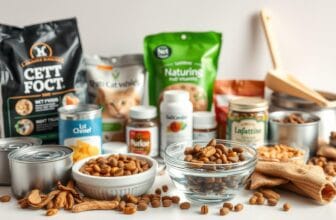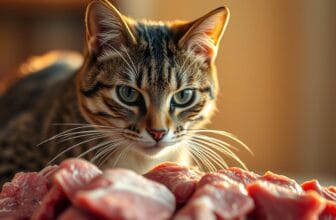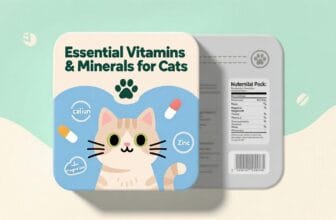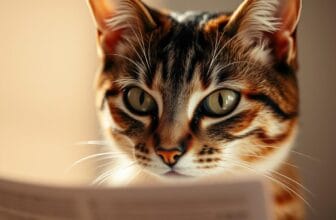
Table of Contents
As a cat owner, you want to make sure your pet eats the right amount. This is key for their health and happiness. With 61% of cats in the U.S. being overweight, knowing how much to feed is very important.
A healthy adult cat can go without food for 1 to 2 weeks. But, not eating for too long can cause serious health problems.
Feeding your cat the right amount helps prevent obesity and diabetes. You need to think about their age, weight, and how active they are. Knowing about cat nutrition and feeding guidelines helps you make good choices for their diet. This ensures they get the nutrients they need for a happy life.
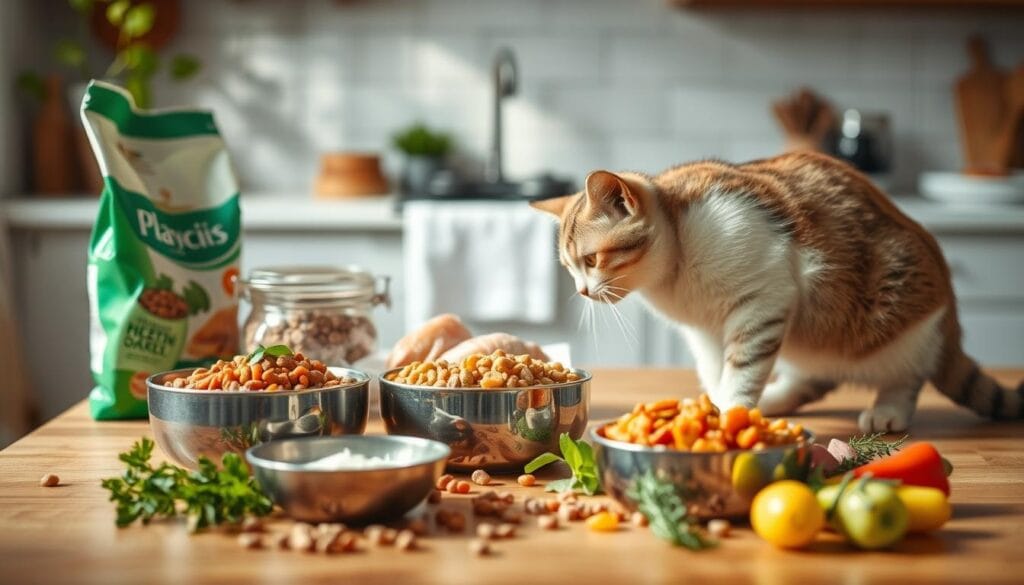
A colorful and vibrant display of various cat food options arranged artistically, featuring dry kibble, wet food in bowls, fish, chicken, and healthy vegetables, surrounded by playful cats examining the food, all set in a cozy kitchen environment with warm lighting.
Understanding Basic Cat Nutrition Requirements
As a cat owner, you want to make sure your cat eats well. Cat nutrition is complex, but knowing the basics is key. The amount of calories your cat needs depends on their age, weight, and how active they are. A healthy adult cat needs about 200-300 calories a day. Kittens need more calories to grow and develop.
Protein, fat, carbs, vitamins, and minerals are vital for your cat’s health. Cats need a diet rich in protein and fat from animal sources. The Association of American Feed Control Officials (AAFCO) says cat food for adult cats must have at least 26% crude protein.
- Taurine, an essential amino acid found in animal-based ingredients
- Vitamin A, crucial for vision and immune function
- Arachidonic acid, an omega-6 fatty acid important for skin and coat health
Knowing your cat’s calorie and nutrient needs helps you give them a balanced diet. This supports their health and happiness. Always talk to your vet to find the best diet for your cat, based on their needs and age.
| Nutrient | Minimum Requirement |
|---|---|
| Crude Protein | 26% on a dry matter basis |
| Crude Fat | 9% on a dry matter basis |
| Carbohydrates | Less than 10% of daily caloric intake |
How Much Do Cats Eat Daily?
Knowing how much cats eat is key to their health. The amount depends on their age, weight, and how active they are. For example, a healthy adult cat needs about 1/4 to 1/2 cup of dry food for every 10 pounds of body weight each day. This means a 10-pound cat needs about 200-250 kcal daily.
Many things can change a cat’s appetite. Their age, weight, and how active they are matter. So does their health. Kittens need more calories because they’re growing. Senior cats might need fewer calories, depending on their health.
It’s important to think about a cat’s lifestyle and health when figuring out their food needs. A cat that tends to gain weight might need fewer calories. On the other hand, a cat that’s underweight might need more. Here’s a breakdown of daily caloric needs for cats:
- Kittens (up to 6 months): 50-75g of dry food or 75-100g of wet food
- Adults (1 to 7 years): 40-60g of dry food or 100g of wet food
- Seniors (7 years and older): 30-40g of dry food or 85g of wet food
Treats should make up no more than 10% of a cat’s daily calories. Canned cat food has about 180 kcal per can. Dry food has around 500 kcal per cup. Knowing how much cats eat helps ensure they get the nutrients they need for good health.
| Age | Weight | Daily Caloric Needs |
|---|---|---|
| Kitten (up to 6 months) | 5 lbs | 157 kcal |
| Adult (1 to 7 years) | 10 lbs | 250 kcal |
| Senior (7 years and older) | 15 lbs | 354 kcal |
Factors Affecting Your Cat’s Food Intake
As a cat owner, it’s key to know what affects your cat’s eating habits. Age, activity level, and health status are important. For example, kittens need more calories for growth. Senior cats might eat less because they’re less active.
A cat’s age is a big factor in how much they eat. Kittens, for instance, need more calories than adult cats. Here are some guidelines for cat food intake based on age:
- Kittens (0-6 months): 2-3 ounces of food per pound of body weight daily
- Young cats (6-12 months): 1-2 ounces per pound of body weight daily
- Adult cats (1-7 years): 1/2 to 1 ounce per pound of body weight daily
- Senior cats (7+ years): similar amounts to adult cats, adjusting based on activity and health status
Other than age, a cat’s activity level and health status also matter. Cats with health issues like diabetes or kidney disease might need special diets. Knowing these factors helps ensure your cat gets the right nutrients for health.
| Age | Food Intake |
|---|---|
| Kittens (0-6 months) | 2-3 ounces per pound of body weight daily |
| Young cats (6-12 months) | 1-2 ounces per pound of body weight daily |
| Adult cats (1-7 years) | 1/2 to 1 ounce per pound of body weight daily |
| Senior cats (7+ years) | similar amounts to adult cats, adjusting based on activity and health status |
Creating an Effective Feeding Schedule
To keep your cat healthy, it’s key to set up a feeding schedule that fits their needs. The right cat nutrition involves the right meal frequency and sizes. Cats are used to eating small meals all day, but this can cause them to eat too much. Instead, feed them 2-3 meals a day, adjusting the size based on their age, weight, and how active they are.
A good feeding schedule helps control your cat’s eating. Cats should eat at least two meals a day, about 12 hours apart. Kittens need more, eating 3-4 times a day. As your cat grows, you can change how often they eat. Using a measuring cup or kitchen scale helps keep their food intake right.
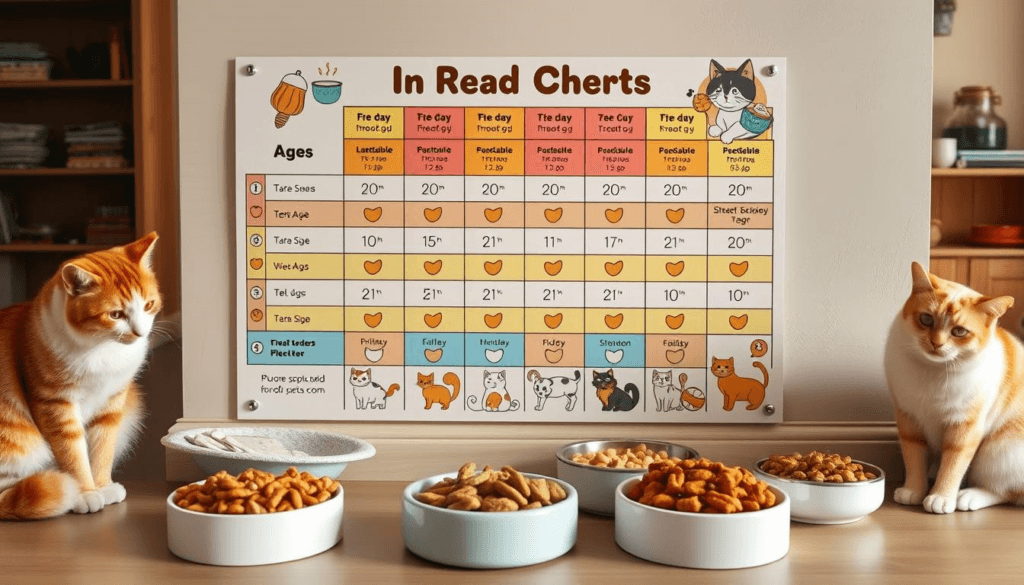
A colorful wall chart displaying a detailed cat feeding schedule, with sections for different cat ages and weights, illustrated with playful cat-themed graphics and icons, surrounded by bowls of various cat foods and treats, set against a cozy home interior backdrop.
- Feed your cat at regular times to create a routine and help them expect food
- Use a measuring cup or kitchen scale to measure daily portions
- Adjust meal frequency and portion sizes based on your cat’s age, weight, and activity level
- Avoid free feeding or grazing, as it can lead to overeating and obesity
By following these tips and setting up a good feeding schedule, you can make sure your cat gets the nutrients they need. Always talk to your vet to find the best feeding schedule for your cat, based on their needs and cat nutrition.
Portion Control Methods for Different Food Types
Feeding your cat the right amount is key to keep them healthy. It’s important to measure and portion food correctly. For dry food, use an 8 oz. measuring cup. Adult cats need about ½ cup to ⅔ cup daily.
Wet food needs vary, with adult cats needing 7-11 oz daily. Remember, treats can add up and lead to overfeeding. Try to keep treats under 10% of your cat’s daily calories.
Measuring Dry Food
Measuring dry food is easy with the right cup. You can also use a food scale for exact amounts.
Portioning Wet Food
Portioning wet food can be tricky. Serving sizes change with different brands and types. Always check the label and adjust as needed for your cat.
Treating Guidelines
Treats are great for rewarding your cat, but use them wisely. Choose low-calorie options and limit them to 10% of your cat’s daily calories. Healthy treats include green beans, carrots, and air-dried liver snacks.
Signs of Proper Food Intake
As a cat owner, you want your cat to be healthy. A good sign is a healthy weight, shiny coat, and good digestion. If your cat eats the right amount, they should look and feel great.
A well-fed cat has lots of energy and loves to play. To know if your cat is eating well, watch their health. Talk to your vet to find the best food for your cat.
Some key signs of proper food intake include:
- Maintaining a healthy weight
- Having a shiny and healthy-looking coat
- Good digestion, with regular bowel movements
- Plenty of energy and being active and playful
By watching these signs and adjusting your cat’s diet, you can help them stay healthy. Always get advice from your vet on your cat’s diet and health.
For more info on cat health and nutrition, talk to your vet or a trusted source. Together, you can ensure your cat gets the food they need to be happy and healthy.
| Age | Weight | Caloric Requirements |
|---|---|---|
| Kitten (0-4 months) | 1-5 lbs | 77.38-353.2 kcal |
| Kitten (4 months to adult) | 5.5-10 lbs | 258.73-453.1 kcal |
| Adult cat | 10 lbs | 348.1 kcal (spayed/neutered), 391.6 kcal (intact) |
Common Feeding Mistakes to Avoid
As a cat owner, you want your cat to be healthy. But, feeding mistakes can harm their health. About 61% of cats in the U.S. are overweight or obese, often due to too much food.
Knowing the risks of overfeeding, underfeeding, and inconsistent feeding is key. Overfeeding can cause obesity and health issues. Underfeeding can lead to malnutrition. Inconsistent feeding can upset your cat’s stomach and cause other health problems.
To avoid these mistakes, understand your cat’s nutritional needs. Create a feeding schedule based on their age, weight, and activity level. This way, you can help your cat stay healthy and avoid weight-related health issues.
Some important feeding tips include:
- Avoid overfeeding by watching how much food your cat eats and adjust as needed.
- Make sure your cat gets enough nutrients to support their growth and health.
- Stick to a regular feeding schedule to prevent inconsistent feeding.
By following these tips and being mindful of common feeding mistakes, you can ensure your cat’s happiness and health.
Special Dietary Considerations
As a cat owner, it’s crucial to think about your cat’s diet needs. Some cats need special dietary considerations because of their life stage or health. For instance, pregnant cats need more calories and nutrients for their health and their kittens’.
Senior cats might need less food and easier-to-digest meals because they’re less active and older. Cats with medical conditions, like kidney disease or diabetes, might need special diets or feeding times to control their condition.
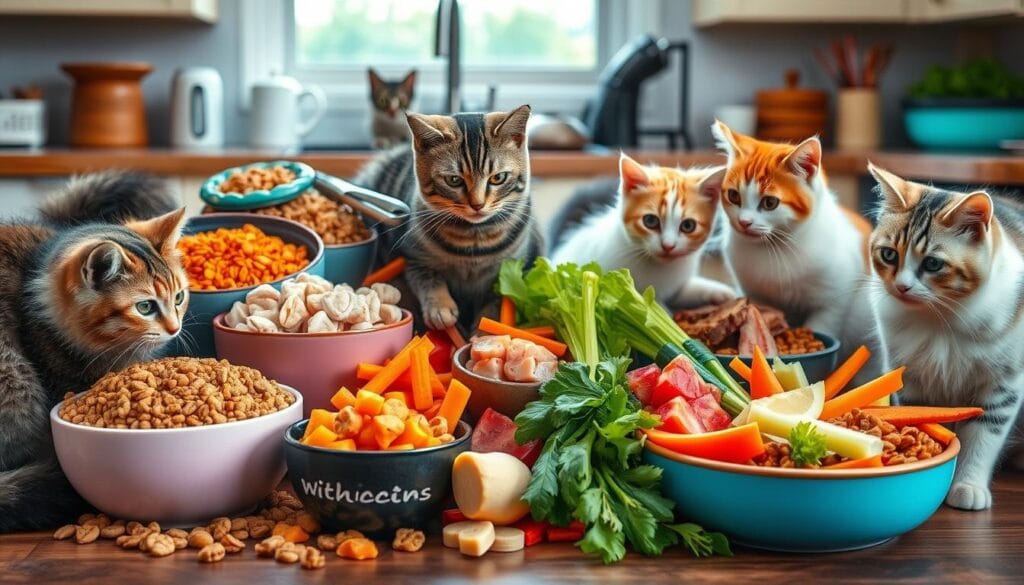
A serene kitchen scene featuring a variety of cat food options, including kibble and wet food, surrounded by fresh ingredients like fish, chicken, vegetables, and herbs. A playful cat curiously explores the food bowls on a wooden table, with soft natural light illuminating the space, creating a warm and inviting atmosphere.
Here are some important things to remember about special diets for your cat:
- Pregnant and nursing cats need more calories and nutrients for their health and their kittens’.
- Senior cats might need less food and easier-to-digest meals because they’re less active and older.
- Cats with medical conditions, like kidney disease or diabetes, might need special diets or feeding times to control their condition.
| Life Stage | Dietary Considerations |
|---|---|
| Pregnant and Nursing Cats | Increased calories and nutrients |
| Senior Cats | Fewer calories, easily digestible foods |
| Cats with Medical Conditions | Special diets or feeding schedules |
When to Adjust Feeding Amounts
As a cat owner, watching your cat’s weight and health is key. You need to see if you should change how much food they get. If their weight or health changes, it might mean they need more or less food.
If your cat is getting too heavy, you might need to feed them less. But if they’re losing weight, you might need to give them more. Adjusting feeding amounts is important to keep them healthy and happy.
Here are some tips for adjusting food amounts:
- Watch your cat’s weight for a few weeks to see if you need to make changes.
- Think about your cat’s age, weight, and how active they are when deciding how much food they need.
- Choose a good quality cat food that has everything they need, and follow the feeding guide on the packet.
Every cat is unique, and they might need different amounts of food. By keeping an eye on your cat’s weight and health, and adjusting feeding amounts as needed, you can help them stay healthy and happy.
Conclusion: Maintaining Healthy Feeding Habits
Keeping your cat’s diet healthy is key to their well-being. By following good cat nutrition tips and adjusting their meals as needed, you help them get the nutrients they need. It’s important to watch their weight and adjust their food portions. If you have any diet or health concerns, always talk to your vet.
With the right diet, your cat can stay healthy and live a long life. This approach ensures they get the balanced nutrition they need. It’s a great way to care for your feline friend.
FAQ: How Much Do Cats Eat?
How much food should an adult cat eat daily?
Adult cats generally need 1/4 to 1/2 cup of dry food or 3-5.5 oz of wet food daily, depending on their size, age, and activity level.
How much should I feed my kitten?
Kittens need more food as they grow. Typically, they should be fed 4-6 meals a day, with amounts increasing based on their growth stages. Consult a vet for specific recommendations.
How often should I feed my cat?
Adult cats typically eat 2 meals per day. Kittens may need to eat more frequently, around 3-4 meals daily.
Can I free-feed my cat?
Free-feeding, where food is left out all day, can work for some cats, especially those that regulate their intake. However, it can lead to overeating or obesity for others, so portion control is often recommended.
How much should I feed an overweight cat?
If your cat is overweight, consider reducing their food intake, feeding smaller meals more frequently, and providing more opportunities for exercise. A vet’s guidance is essential in creating a safe weight-loss plan.
How much should I feed my senior cat?
Senior cats may require fewer calories, but they still need a balanced diet. Depending on their health, consult your vet to adjust portions or recommend specialized food.
How do I know if I’m feeding my cat the right amount?
Monitor your cat’s weight, activity level, and overall health. If your cat is gaining or losing weight unexpectedly, adjust their food portions accordingly or seek advice from your vet.
Can I give my cat treats in addition to their regular food?
Treats should be given in moderation, making up no more than 10% of your cat’s daily calorie intake to avoid upsetting their balanced diet.
How much water should my cat drink?
Cats typically drink 2-4 oz of water per 5 pounds of body weight daily. Cats who eat mostly wet food may drink less water, as the food contains moisture. Always provide fresh water.
Source Links
- How Much To Feed a Cat: Portions, Counting Calories, and More – https://be.chewy.com/how-much-should-i-feed-my-cat/
- How Much To Feed a Cat – https://www.petmd.com/cat/nutrition/how-much-to-feed-a-cat
- Ask the Vet: How Much Should I Feed My Cat? Feeding Chart – https://www.litter-robot.com/blog/how-much-should-i-feed-my-cat/?srsltid=AfmBOopTkj5plkCCi4DOAIlvlhmQcM4C6kwxVrsHxBa-Mz7Pnw59IIt8
- Cat Nutrition: What Makes a Nutritional Cat Food? – https://www.petmd.com/cat/nutrition/cat-nutrition-what-makes-nutritional-cat-food
- Nutrition – General Feeding Guidelines for Cats | VCA Animal Hospitals – https://vcahospitals.com/know-your-pet/nutrition-feeding-guidelines-for-cats
- How Much to Feed a Cat | Learn How Much Your Cat Should Eat a Day with Our Cat Feeding Chart – https://www.embracepetinsurance.com/waterbowl/article/feeding-your-cat
- Decoding How Much Do Cats Eat: Your Guide to Feeding – https://petmedaily.com/how-much-do-cats-eat/
- Why Your Cat’s Eating and Drinking Habits Change – Just Cats Clinic – https://justcatsclinic.com/why-your-cats-eating-and-drinking-habits-change/
- Feeding Times and Frequency for Your Cat | VCA Animal Hospitals – https://vcahospitals.com/know-your-pet/feeding-times-and-frequency-for-cats
- How often should you feed your cat? – https://www.vet.cornell.edu/departments/cornell-feline-health-center/health-information/feline-health-topics/how-often-should-you-feed-your-cat
- Ask the Vet: How Much Should I Feed My Cat? Feeding Chart – https://www.litter-robot.com/blog/how-much-should-i-feed-my-cat/?srsltid=AfmBOoraNvro5M04JBOKHz6H1eZO-w9xbiP3XelY74bB0IHKRLrqk6dR
- How Much to Feed Your Cat | Stella & Chewy’s – Stella & Chewy’s – https://www.stellaandchewys.com/blogs/articles/how-much-to-feed-cats?srsltid=AfmBOorw1PWSjqoKbMpro0q-WzLRdX2fQwv59TKe5yK9EEDLRO-Zijbf
- How Much and How Often You Should Feed Your Cat | Preventive Vet – https://www.preventivevet.com/cats/how-much-and-how-often-to-feed-your-cat
- Feeding Your Cat – https://www.vet.cornell.edu/departments-centers-and-institutes/cornell-feline-health-center/health-information/feline-health-topics/feeding-your-cat
- How Often & How Much Should I Feed My Cat | Petbarn – https://www.petbarn.com.au/petspot/cat/food-and-nutrition-cat/often-feed-cat/?srsltid=AfmBOorpMUncFV8ZhFnDpQjAkjbHM3pKSvTIzzZaAfohy-gDQM2hvrFi
- How much to feed a cat? – https://www.vetalogica.com.au/blogs/news/how-much-to-feed-a-cat?srsltid=AfmBOoqnDvnuLqqip7QGdCTIyOBFghPyYZjBvsfi0fnJoQQdLeqIApfu
- How Much Raw Food Should I Feed My Cat? | Iron Will Raw – https://ironwillrawdogfood.com/blogs/news/how-much-raw-food-should-i-feed-my-cat?srsltid=AfmBOoqX8Rr6fq6EIjPFFq9M8xsbTCc-Aidyd9GoPp6Q7nzbZWC2CRs2
- How Much to Feed Your Cat | Stella & Chewy’s – Stella & Chewy’s – https://www.stellaandchewys.com/blogs/articles/how-much-to-feed-cats?srsltid=AfmBOookF73LkfXpHsMTNqVf-_KGBajBxnHL-iOkyzQzMok0xCrPGRup
- How to Feed Your Cat So It Stops Begging and Starts Losing Weight – Companion Animal Clinic – https://companion-vets.com/topics/nutrition/cat-feeding-guide-stop-begging-lose-weight/
- Ask the Vet: How Much Should I Feed My Cat? Feeding Chart – https://www.litter-robot.com/blog/how-much-should-i-feed-my-cat/?srsltid=AfmBOoowAShUzMiE_m7dR3kv8HU4C1WYrt8hf6nNWm3AFkizCExWA8zS



